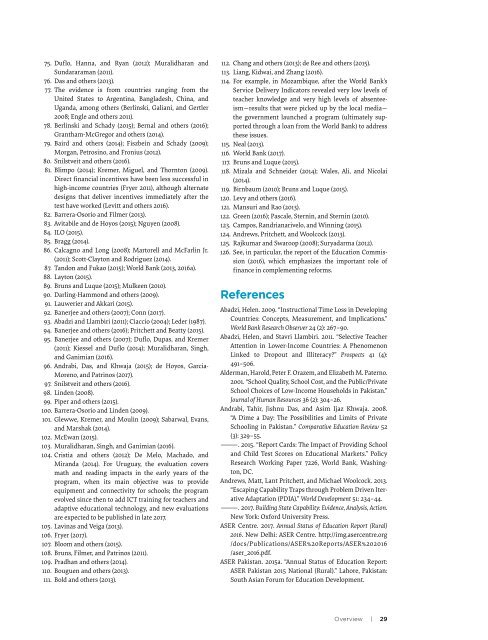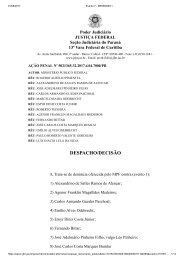Brasil só deve dominar Leitura em 260 anos, aponta estudo do Banco Mundial Relatorio Banco Mundial _Learning
You also want an ePaper? Increase the reach of your titles
YUMPU automatically turns print PDFs into web optimized ePapers that Google loves.
75. Duflo, Hanna, and Ryan (2012); Muralidharan and<br />
Sundararaman (2011).<br />
76. Das and others (2013).<br />
77. The evidence is from countries ranging from the<br />
United States to Argentina, Bangladesh, China, and<br />
Uganda, among others (Berlinski, Galiani, and Gertler<br />
2008; Engle and others 2011).<br />
78. Berlinski and Schady (2015); Bernal and others (2016);<br />
Grantham-McGregor and others (2014).<br />
79. Baird and others (2014); Fiszbein and Schady (2009);<br />
Morgan, Petrosino, and Fronius (2012).<br />
80. Snilstveit and others (2016).<br />
81. Blimpo (2014); Kr<strong>em</strong>er, Miguel, and Thornton (2009).<br />
Direct financial incentives have been less successful in<br />
high-income countries (Fryer 2011), although alternate<br />
designs that deliver incentives immediately after the<br />
test have worked (Levitt and others 2016).<br />
82. Barrera-Osorio and Filmer (2013).<br />
83. Avitabile and de Hoyos (2015); Nguyen (2008).<br />
84. ILO (2015).<br />
85. Bragg (2014).<br />
86. Calcagno and Long (2008); Martorell and McFarlin Jr.<br />
(2011); Scott-Clayton and Rodriguez (2014).<br />
87. Tan<strong>do</strong>n and Fukao (2015); World Bank (2013, 2016a).<br />
88. Layton (2015).<br />
89. Bruns and Luque (2015); Mulkeen (2010).<br />
90. Darling-Hammond and others (2009).<br />
91. Lauwerier and Akkari (2015).<br />
92. Banerjee and others (2007); Conn (2017).<br />
93. Abadzi and Llambiri (2011); Ciaccio (2004); Leder (1987).<br />
94. Banerjee and others (2016); Pritchett and Beatty (2015).<br />
95. Banerjee and others (2007); Duflo, Dupas, and Kr<strong>em</strong>er<br />
(2011); Kiessel and Duflo (2014); Muralidharan, Singh,<br />
and Ganimian (2016).<br />
96. Andrabi, Das, and Khwaja (2015); de Hoyos, Garcia-<br />
Moreno, and Patrinos (2017).<br />
97. Snilstveit and others (2016).<br />
98. Linden (2008).<br />
99. Piper and others (2015).<br />
100. Barrera-Osorio and Linden (2009).<br />
101. Glewwe, Kr<strong>em</strong>er, and Moulin (2009); Sabarwal, Evans,<br />
and Marshak (2014).<br />
102. McEwan (2015).<br />
103. Muralidharan, Singh, and Ganimian (2016).<br />
104. Cristia and others (2012); De Melo, Macha<strong>do</strong>, and<br />
Miranda (2014). For Uruguay, the evaluation covers<br />
math and reading impacts in the early years of the<br />
program, when its main objective was to provide<br />
equipment and connectivity for schools; the program<br />
evolved since then to add ICT training for teachers and<br />
adaptive educational technology, and new evaluations<br />
are expected to be published in late 2017.<br />
105. Lavinas and Veiga (2013).<br />
106. Fryer (2017).<br />
107. Bloom and others (2015).<br />
108. Bruns, Filmer, and Patrinos (2011).<br />
109. Pradhan and others (2014).<br />
110. Bouguen and others (2013).<br />
111. Bold and others (2013).<br />
112. Chang and others (2013); de Ree and others (2015).<br />
113. Liang, Kidwai, and Zhang (2016).<br />
114. For example, in Mozambique, after the World Bank’s<br />
Service Delivery Indicators revealed very low levels of<br />
teacher knowledge and very high levels of absenteeism—results<br />
that were picked up by the local media—<br />
the government launched a program (ultimately supported<br />
through a loan from the World Bank) to address<br />
these issues.<br />
115. Neal (2013).<br />
116. World Bank (2017).<br />
117. Bruns and Luque (2015).<br />
118. Mizala and Schneider (2014); Wales, Ali, and Nicolai<br />
(2014).<br />
119. Birnbaum (2010); Bruns and Luque (2015).<br />
120. Levy and others (2016).<br />
121. Mansuri and Rao (2013).<br />
122. Green (2016); Pascale, Sternin, and Sternin (2010).<br />
123. Campos, Randrianarivelo, and Winning (2015).<br />
124. Andrews, Pritchett, and Woolcock (2013).<br />
125. Rajkumar and Swaroop (2008); Suryadarma (2012).<br />
126. See, in particular, the report of the Education Commission<br />
(2016), which <strong>em</strong>phasizes the important role of<br />
finance in compl<strong>em</strong>enting reforms.<br />
References<br />
Abadzi, Helen. 2009. “Instructional Time Loss in Developing<br />
Countries: Concepts, Measur<strong>em</strong>ent, and Implications.”<br />
World Bank Research Observer 24 (2): 267–90.<br />
Abadzi, Helen, and Stavri Llambiri. 2011. “Selective Teacher<br />
Attention in Lower-Income Countries: A Phenomenon<br />
Linked to Dropout and Illiteracy?” Prospects 41 (4):<br />
491–506.<br />
Alderman, Harold, Peter F. Oraz<strong>em</strong>, and Elizabeth M. Paterno.<br />
2001. “School Quality, School Cost, and the Public/Private<br />
School Choices of Low-Income Households in Pakistan.”<br />
Journal of Human Resources 36 (2): 304–26.<br />
Andrabi, Tahir, Jishnu Das, and Asim Ijaz Khwaja. 2008.<br />
“A Dime a Day: The Possibilities and Limits of Private<br />
Schooling in Pakistan.” Comparative Education Review 52<br />
(3): 329–55.<br />
————. 2015. “Report Cards: The Impact of Providing School<br />
and Child Test Scores on Educational Markets.” Policy<br />
Research Working Paper 7226, World Bank, Washington,<br />
DC.<br />
Andrews, Matt, Lant Pritchett, and Michael Woolcock. 2013.<br />
“Escaping Capability Traps through Probl<strong>em</strong> Driven Iterative<br />
Adaptation (PDIA).” World Development 51: 234–44.<br />
————. 2017. Building State Capability: Evidence, Analysis, Action.<br />
New York: Oxford University Press.<br />
ASER Centre. 2017. Annual Status of Education Report (Rural)<br />
2016. New Delhi: ASER Centre. http://img.asercentre.org<br />
/<strong>do</strong>cs/Publications/ASER%20Reports/ASER%202016<br />
/aser_2016.pdf.<br />
ASER Pakistan. 2015a. “Annual Status of Education Report:<br />
ASER Pakistan 2015 National (Rural).” Lahore, Pakistan:<br />
South Asian Forum for Education Development.<br />
Overview | 29








